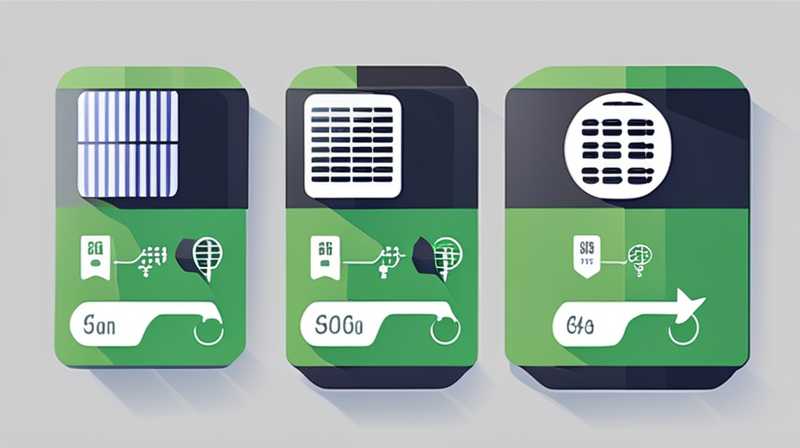
1. The cost of replacing solar charging panels typically ranges between $1,000 and $3,500, depending on several factors, including the type and size of the panels, installation fees, and local market rates. 2. In most cases, installation costs account for a significant portion of the expenses, often ranging from $2 to $3 per watt. 3. A detailed assessment of energy needs and panel compatibility can help in understanding the exact expenses involved. 4. Choosing a reputable installer can provide warranties and guarantee the longevity of the investment.
UNDERSTANDING THE EXPENSE OF SOLAR PANEL REPLACEMENT
The transition to solar energy has gained momentum in recent years, prompting an increasing number of households and businesses to consider solar power as a viable energy source. However, solar panels, like any other electrical appliance, have a finite lifespan, typically ranging between 25 to 30 years. Eventually, these panels may necessitate replacement due to reduced efficiency, physical damage, or advancements in technology. The question arises: how much does one need to budget for replacing solar charging panels? This exploration delves into the costs associated with this crucial decision, providing a comprehensive overview of various influencing factors.
The cost of replacement rests on multiple factors, such as the type and brand of solar panels chosen, as well as installation expenses linked to hiring professionals. Solar panel systems possess varying power outputs, commonly measured in watts. Prices fluctuate based on the wattage, quality, and technology employed, rendering a broad spectrum of costs available in the market. Moreover, geographical location influences the pricing dynamic. Different regions may exhibit variations in labor costs, local regulations, and available incentives, all contributing to the overall expense.
FACTORS INFLUENCING SOLAR PANEL REPLACEMENT COSTS
1. TYPE OF SOLAR PANELS
A pivotal aspect influencing solar panel replacement costs is the type of solar panels chosen. Solar panels generally encompass three primary categories: monocrystalline, polycrystalline, and thin-film panels. Monocrystalline panels typically provide the highest efficiency rates and occupy less space but are also the most expensive. Their manufacturing process, which derives from high-purity silicon, tends to be costlier, thus reflecting a premium price tag.
Polycrystalline panels, while slightly less efficient, offer a lower-cost alternative, making them a popular choice for budget-conscious consumers. Their manufacturing involves melting multiple silicon fragments together, leading to lower production costs. Thin-film panels present another economical option, generally favored for their lightweight characteristics and flexibility, albeit at a sacrifice in efficiency. Selecting the right type of solar panels will invariably impact the overall cost of replacement and should align with the individual’s or business’s energy needs and budgetary constraints.
2. INSTALLATION FEES
Installation fees constitute a significant segment of the overall costs associated with replacing solar panels. Relying on professionals generally ensures a high-standard installation, safeguarding the longevity and efficiency of the solar system. Professional installers offer the expertise and experience necessary to tackle potential challenges that may arise during installation, such as structural issues, electrical connections, and adherence to local regulations.
The installation costs can range widely based on geographical location, local labor markets, and system complexity. Calculated on a per-watt basis, installation expenses typically range between $2.00 and $3.00 per watt. Thus, a solar power system boasting a capacity of 5 kW might incur installation costs between $10,000 and $15,000 when considering additional features such as inverters, batteries, and support structures. In this regard, it remains essential to obtain multiple quotes from credible contractors to secure competitive pricing and reliable service.
3. ADDITIONAL COMPONENTS AND ACCESSORIES
Beyond the panels themselves and the associated installation costs, various ancillary components and accessories can contribute to the financial outlay. For instance, solar inverters play an essential role, converting direct current (DC) electricity generated by panels into alternating current (AC) electricity utilized within homes or businesses. The type of inverter selected—string inverters, microinverters, or power optimizers—will affect the replacement costs. Generally, a good-quality inverter may range from $1,000 to $3,000.
Moreover, other accessories such as mounting systems and battery storage should also be taken into account. Mounting systems keep the panels securely anchored and tilted at optimal angles for sunlight exposure. An efficient battery storage system can store excess energy generated during the day for use during nighttime or cloudy periods. Depending on individual needs and choices, these additional components can add to the overall expense, necessitating careful consideration when planning for replacement.
4. GEOGRAPHICAL INFLUENCES ON COST
Another significant factor influencing the costs associated with solar panel replacement is geographic location. Different regions exhibit fluctuations in solar panel pricing, installation fees, and available incentives, which can all impact the overall expense. For instance, areas that experience abundant sunlight may necessitate fewer panels and therefore reduce upfront costs but may have higher installation fees due to demand.
Local regulations and building codes also play a role in determining replacement costs. Some regions may impose stringent requirements that necessitate additional services or equipment, thereby raising expenses. Furthermore, specific areas might also offer incentives, such as rebates or tax credits targeting solar energy users, which can offset some costs. By understanding regional variances, individuals can make informed decisions regarding their solar panel replacement and optimize the financial outlay.
5. LONG-TERM VALUE AND RETURN ON INVESTMENT
Examining the costs of solar panel replacement extends beyond immediate expenses. There exists a considerable long-term value to consider, particularly in terms of energy savings and the potential returns on investment. Although the initial costs may deter some individuals or businesses, long-term electricity savings can accumulate over the lifespan of the solar system.
Solar panels yield valuable energy savings by substantially reducing or even eliminating electricity bills. Additionally, as energy prices fluctuate, having a solar energy system can offer stability and immunity to rising utility costs. Many solar installations also boost property values. Research has indicated that homes equipped with solar panels tend to sell for a premium compared to analogous properties without solar installations. Consequently, when contemplating replacement, it is crucial to assess the long-term benefits juxtaposed against the immediate financial burden.
6. WARRANTIES AND MAINTENANCE COSTS
Solar panels typically come with warranties that guarantee performance over time, with many manufacturers offering at least 25 years of coverage for efficiency and durability. When considering replacement, it’s essential to review the warranty details, as panels with stronger warranties may justify higher costs. The assurance provided by a warranty can ensure that an investment will deliver reliable performance for decades.
Furthermore, periodic maintenance tasks such as cleaning and inspecting the panels can incur additional expenses. Although solar panels require minimal maintenance, ensuring they remain clean and free of debris maximizes their efficiency and longevity. The costs for routine maintenance vary, usually ranging from a few hundred to a thousand dollars, dependent on the frequency and depth of service. By factoring in warranties and maintenance, individuals can attain a clearer understanding of the complete financial commitment associated with solar panel replacement.
FREQUENTLY ASKED QUESTIONS
WHAT ARE THE SIGNS THAT SOLAR PANELS NEED REPLACEMENT?
Condensing the signs that solar panels require replacement into a succinct list can assist homeowners in identifying potential issues promptly. Common indicators include reduced energy output, physical damage, and age. Initially, if energy bills suddenly spike despite solar usage and output seems diminished, this could signify inefficiency in the solar system. A marked decrease in output should prompt further investigation.
Secondly, examining the physical condition of solar panels is paramount; observable cracks, peeling, or discoloration may indicate that a panel has been compromised. Furthermore, if solar panels exceed their typical lifespan of 25 to 30 years, they are likely to become less efficient, warranting consideration for replacement. Immediately addressing these signs ensures the solar system operates effectively and maximizes energy savings.
HOW LONG DO SOLAR PANELS LAST BEFORE REPLACEMENT IS NECESSARY?
Typically, most solar panels possess a lifespan of approximately 25 to 30 years before replacements become necessary. Manufacturers design modern solar panels to withstand various environmental factors, ensuring durability and resilience over time. However, it is crucial to note that while panels may continue to function beyond their expected lifespan, their efficiency may diminish, resulting in reduced energy output.
As solar technology advances, older panels may also lag behind newer, more efficient models, further compelling users to consider replacement. Given the significance of panel longevity, regular maintenance and adherence to manufacturer guidelines can help prolong the life and effectiveness of solar systems. Consequently, ensuring optimal performance over the years ultimately influences the timeline for potential replacements.
ARE THERE ANY INCENTIVES OR REBATES AVAILABLE FOR SOLAR PANEL REPLACEMENT?
In many regions, various incentives and rebates are available to assist individuals and businesses in offsetting the costs associated with solar panel replacement. Numerous local and federal programs aim to promote solar energy adoption, acknowledging the long-term benefits to the environment and economy. Tax credits, such as the federal Investment Tax Credit (ITC), can offer as much as 26% of the initial costs related to solar installations as a tax deduction.
Moreover, individual states and municipalities often provide additional incentives, including rebates and grants, for solar panel installation and replacement. Engaging in thorough research to identify eligible incentives can significantly reduce overall expenses, thus enhancing the appeal of investing in solar technology. Keeping informed regarding available incentives empowers prospective buyers to make educated decisions regarding their solar panel replacements, ultimately streamlining the cost-efficiency of their investments.
In summary, costs associated with replacing solar charging panels can vary significantly based on factors such as the type of panels, installation fees, additional components, and geographical influences. Aspiring users need to weigh the immediate financial requirements against the long-term benefits of energy savings, enhanced property value, and advancements in technology. Investing in high-quality solar panels and professionals ensures a reliable system that minimizes future expenses while maximizing efficiency. Additionally, taking stock of available incentives can also greatly augment affordability. Planning for solar panel replacement encompasses a blend of prudence and foresight, crucial for enjoying the myriad benefits of this sustainable energy solution.
Original article by NenPower, If reposted, please credit the source: https://nenpower.com/blog/how-much-does-it-cost-to-replace-solar-charging-panels/


